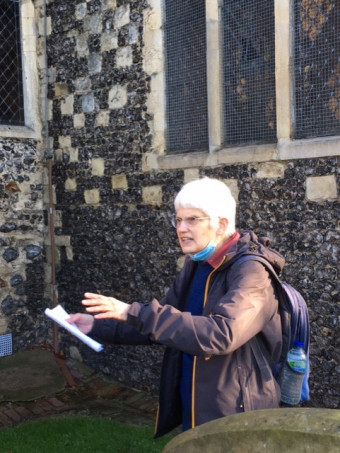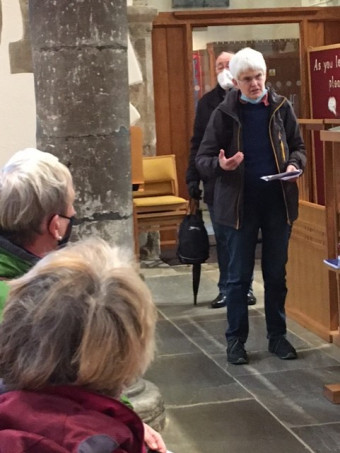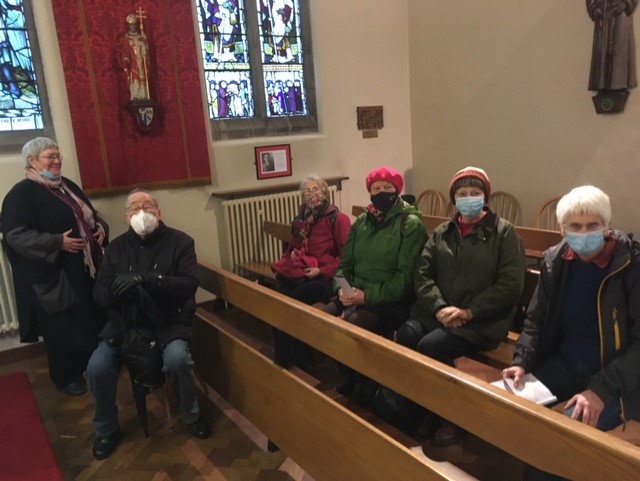As we head towards the end of term and what remains a somewhat uncertain state regarding the type and level of activities/restrictions that may come to pass, I thought I would mention that the Centre’s staff members have been busy teaching.
For example, this meant Dr Diane Heath visited Stonehenge, Bath, Winchester and Salisbury last weekend with the British Studies students, and I had two groups in Canterbury Cathedral Archives this week exploring a range of late medieval and Tudor documents and maps, from the first of the city chamberlains’ account books, with its references to the Great Famine of 1315, the Great Pestilence of 1348 and ‘another mortality’ in 1361, to the fines incurred for ‘keeping a harlot’ or being a ‘common scold’ to be found in the early 16th-century quarter sessions of Canterbury.

In addition, last Saturday I joined pilgrims from the South-East regional group of the CSJ, the Confraternity of St James [ https://www.csj.org.uk/ ], who in some way or other are interested in or have done the Camino de Santiago (Way of St James) which is a network of ancient trails across western Europe to the internationally important shrine of St James the Great at Compostela. The idea last Saturday was for members of this regional branch of the CSJ to do a short pilgrimage through Canterbury, starting at St Dunstan’s church and ending at St Martin’s church. As a means of providing a further dimension, Helen, the organiser, had asked if I would be happy to accompany them to provide information about the history of the various churches along the way, as well as information about pilgrimage and Canterbury in the Middle Ages.
Consequently at 10am after Helen Nattrass and the group had sung an antiphon for St Dunstan, an action they repeated at all the churches, I gave them a brief history of the church from its pre-Conquest beginnings through to the building of the Roper chantry in brick in the early 16th century. For pilgrimage, there was Henry II’s penitential pilgrimage and the role of first St Nicholas’s hospital at Harbledown and then St Dunstan’s church as significant points on his way to Becket’s tomb in the cathedral crypt. Followed by another Thomas and another Henry – Thomas More and Henry VIII, and thus the relic of Thomas More’s head in the vault within the Roper chantry.

Our next stop was St Peter’s church, thereby moving from St Dunstan’s originally under the patronage of the archbishop to a church held in medieval times by Christ Church Priory. From my perspective, structurally one of the most interesting matters is the location of the junction between the late medieval chancel and nave (the position of the rood loft and screen), which is further west than you might expect and means the medieval nave and chancel were of a similar length.
Moving on again, we explored St Mildred’s which is a gem of a medieval church having a considerable amount of pre-Conquest fabric that denotes the size of the original nave, windows from every century between the 13th and 16th centuries and another Tudor chantry chapel. Moreover, the link between saint and pilgrimage may be especially pertinent here because the church was apparently founded just after the St Augustine’s Abbey monks had brought back St Mildred’s relics from Thanet, and what more natural action than to provide an actual relic of her within the newly consecrated high altar in the mid-1030s.

Our pilgrimage next took us to the Franciscan Gardens, a tranquil open space in the city centre where probably the friary guest house has now been established as a chapel. For the first friars, it was those at the Poor Priests’ Hospital over the river who had been their greatest friends, but between 1275 and 1314 the Franciscans also provided the lecturer for Christ Church Priory’s school of theology. However, in relation to pilgrimage, it was the executions for high treason in 1534 of Friar Hugh Riche and Friar Risby as leading supporters of Elizabeth Barton, who can be remembered at this former friary as martyrs for their faith.
For the pilgrims, their visit to Canterbury Cathedral involved meeting the canon on duty who escorted us to the crypt chapel of the Holy Innocents with its fantastic beasts on the crypt capitals. There he spoke about his personal sense of the spiritual importance of pilgrimage before saying a ‘journey prayer for a pilgrim, from Carmina Gadelica’, which the pilgrims found very moving. We then retraced our steps to visit the four places medieval pilgrims probably visited when coming to venerate St Thomas – the martyrdom, the site of his tomb shrine in the crypt, the location of the shrine in the Trinity chapel and the Corona chapel. Moreover, for good measure the pilgrims also noted where the altars of St Dunstan and St Alphage had been, and that although the cult never achieved popularity, the potential for yet another murdered archbishop – the tomb of Simon Sudbury.

After lunch, the pilgrims visited St Paul’s church, another church that in medieval times had been under the patronage of St Augustine’s Abbey and there we saw out third parish chantry chapel. However, in this case Hamo Doge’s chantry was not a small side chancel chapel but one that dwarfed the church’s original chancel and nave. This later 13th-century appropriation suggests almost a privatisation of the parish church and in the Victorian Gothic revival of St Paul’s church, this Lady Chapel and aisle would become the chancel and nave with a further south aisle added.
Keeping with the idea of Victorian Gothic, we crossed back into the walled city through what had been Burgate with St Michael’s church and entered St Thomas’ RC church. Built in the mid 1870s to a design influenced by the ideas of Pugin, this church holds two relics of Thomas Becket and one of Oscar Romero, archbishop of San Salvador, in the Martyrs Chapel. Helen had arranged for the priest to be present to allow the pilgrims who wished to venerate the bone relic of Becket to do so.

Our final destination was St Marin’s church, the third part of Canterbury’s UNESCO World Heritage site and, as at the other churches, we were welcomed by one of the parishioners. As at St Mildred’s, I felt it was important to highlight the external fabric as a way of understanding the church’s origins and then we went back inside to look at how we could read the church’s structural development over the centuries. We also explored ideas about the place of Roman Christianity in the late 6th century kingdom of Kent and how thinking about the national and continental contexts can provide a better understanding of why these developments took place.
Thus ended our pilgrimage through Canterbury which the pilgrims had thoroughly enjoyed from the comments made, and from the donations which they provided for the Ian Coulson Memorial Postgraduate Award Fund. Indeed, the fund has received a couple of other donations recently and we at the Centre would like to thank all these donors because it means we can continue to aid postgraduates working on Kent history topics.
Just as a postscript this week, it was sad to say goodbye to Dr Rachel Koopmans who flew back to Canada yesterday, but it won’t be that many months before she will be in Canterbury again. It is brilliant to know that she will be returning on the Medieval Canterbury Weekend 2022 ie Friday 29th April to Sunday 1st May, and thereafter for a couple of months she will be working again with Leonie Seliger and her team in the cathedral’s glass studio. Although only at the early planning stage at present, we are intending to have a joint Centre and Glass Studio study day that will include talks by both Rachel and Leonie – watch this space over the coming months.

For a different project, I spent yesterday afternoon in the cathedral archives with Jason Mazzocchi from the Lossenham Project and among other matters we were looking at a copy of John Speed’s map of Kent, which among other matters demonstrates the importance of the bridge at Newenden on the Rother, and the bedel’s roll for the Christ Church Priory manor of Ebony from 1299-1300. Even though this manor does not coincide topographically with Newenden, it is close enough to give some idea of the farming practices at least by the great lords if not the peasantry for this area of the Rother Levels, as well as information on the Ebony ferry, the type of estate buildings there, and the importance of maintaining the marshland defences against flooding. Finally, next week we will be to a degree staying in west Kent for Richard’s presentation on his case studies to the Kent History Postgraduates group.
 Centre for Kent History and Heritage
Centre for Kent History and Heritage Sheila Sweetinburgh
Sheila Sweetinburgh 921
921


I so enjoyed reading this. What an impressive report.
My email does not have a capital P
Great, thanks Philippa, delighted to hear that. I think the capital ‘P’ is due to the automatic system.
Best wishes, Sheila